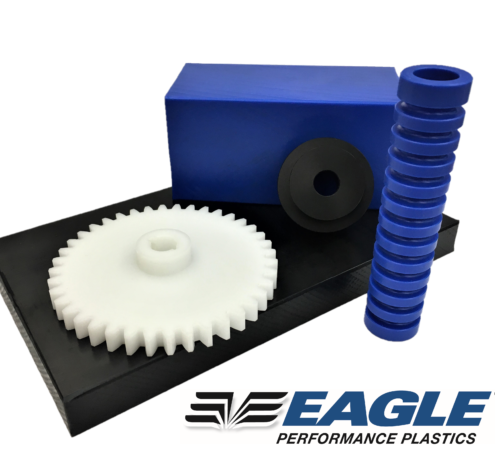PAI Bearing Grade

Overview
What is the Material: PAI Bearing Grade is an imidized amorphous material filled with PTFE (Teflon) and graphite.
Key Material Features: This material is beneficial in applications requiring a lower coefficient of friction, while maintaining the properties of other PAI materials including high strength, dimensional stability, diverse chemical resistance, and it maintains its properties at elevated temperatures.
Other Considerations: This material is attacked by hot water and steam.
Physical
| Property | Value | Typical ASTM Test |
|---|---|---|
| Chemical Designation | (PAI) Polyamide-imide | |
| Trade Names (®, ™) | Torlon, Tecapai, Duratron | |
| Filler | Graphite, PTFE | |
| Color | Black | |
| Density (g/cm^3) | 1.51 | D 792 |
Mechanical
| Property | Value | Typical ASTM Test |
|---|---|---|
| Modulus of Elasticity (Tensile Test) (psi) | 580000 | D 638 |
| Tensile Strength at Yield (psi) | 15500 | D 638 |
| Tensile Strength at Break (psi) | 9300 | D 638 |
| Elongation at Break (%) | 3.1 | D 638 |
| Flexural Strength (psi) | 15000 | D 790 |
| Modulus of Elasticity (Flexural Test) (psi) | 580000 | D 790 |
| Compression Strength: 10% Strain (psi) | 22000 | D 695 |
| Compression Strength: 1% Strain (psi) | 4500 | D 695 |
| Compression Modulus (psi) | 350000 | D 695 |
| Impact Strength (Izod) (ft-lbs/in) | 0.6 | D 256 |
| Hardness (D) | 88 | D 785 |
| Hardness (E) | 76 | |
| Hardness (M) | 114 | D 785 |
| Coefficient of Friction (Kinetic, 40 psi, 50 fpm) | 0.18 | D 3702 |
| Coefficient of Friction (Static) | 0.14 | D 3702 |
| Wear (K) Factor (in^3-min/ft-lbs-hr) (Against Steel, 40 psi, 50 fpm) | 3.15E-8 | D 3702 |
Thermal
| Property | Value | Typical ASTM Test |
|---|---|---|
| Glass Transistion Temperature (°F) | 529 | D 3418 |
| Deflection Temperature (°F) (264 psi) | 500 | D 648 |
| Thermal Expansion (CLTE) (in/in/°F) | 1.94E-5 | D 696 |
| Thermal Conductivity (BTU-in/hr-ft^2-°F) | 2.81 |
Electrical
| Property | Value | Typical ASTM Test |
|---|---|---|
| Specific Surface Resistance (Ω/square) | 1.00E13 | D 257 |
Other
| Property | Value | Typical ASTM Test |
|---|---|---|
| Moisture Absorption (%) (24 Hours) | 0.2 | D 570 |
| Moisture Absorption (%) (Saturated) | 1.6 | D 570 |
| Flammability | V-0 |
The data stated are typical values intended for reference and comparison purposes only. The data should not be used as a basis for design specifications or quality control. The information is provided as a guide to the best of our knowledge and given without obligation or liability. Testing under individual application circumstances is recommended.
